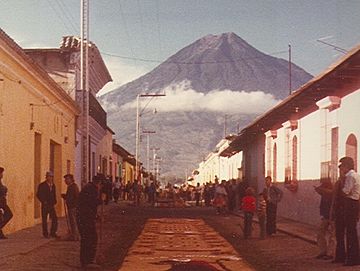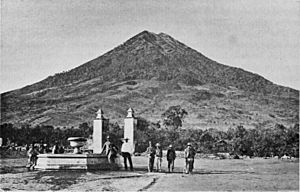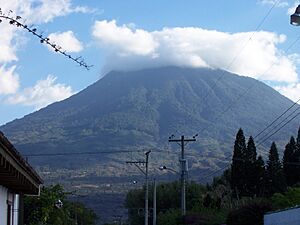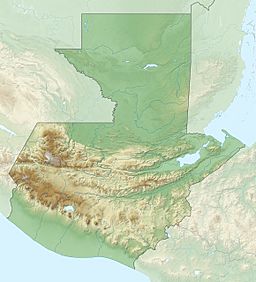Volcán de Agua facts for kids
Quick facts for kids Volcán de Agua |
|
|---|---|

Volcán de Agua, seen from Antigua, Guatemala, with temporary street carpeting for Easter celebrations in foreground.
|
|
| Highest point | |
| Elevation | 3,760 m (12,340 ft) |
| Naming | |
| English translation | Volcano of Water |
| Language of name | Spanish |
| Geography | |
| Geology | |
| Mountain type | Stratovolcano |
| Volcanic arc/belt | Central America Volcanic Arc |
| Last eruption | Late Pleistocene |
Volcán de Agua is a large volcano in Guatemala. People also call it Hunahpú, which is its name in the Maya language. This volcano is a type called a stratovolcano, known for its tall, cone shape.
It stands in the Sacatepéquez and Escuintla areas of Guatemala. Volcán de Agua is about 3,760 m (12,340 ft) tall. It rises high above the Pacific coast and the Guatemalan Highlands. The volcano is a major part of the local view.
Many towns are close to the volcano. The city of Antigua Guatemala is only 5 to 10 km (3.1 to 6.2 mi) away. These towns have nearly 100,000 people living in them. Farmers also grow Coffee on the lower parts of the volcano.
Contents
What is the history of Volcán de Agua?
The local Kaqchikel people have always called this volcano Hunapú. This name means "place of flowers" or "one hunter." It is a special name in their culture.

The Spanish explorers also used the name Hunapú. But this changed after a big disaster. On September 10, 1541, a huge mudslide from the volcano destroyed Guatemala's first capital city. This city is now called Ciudad Vieja.
The city was moved to Antigua Guatemala after this event. The mudslide was full of water and mud. This is why the volcano got its modern name, "Volcán de Agua." This means "Volcano of Water." It is different from the nearby "Volcán de Fuego" or "Volcano of Fire." The Kaqchikel people call Volcan de Fuego Chi Gag, meaning "where the fire is."
When did Volcán de Agua last erupt?
Volcán de Agua was active a long time ago. This was during the late Pleistocene period, between 80,000 and 10,000 years ago. It has not erupted since then.
Even though it has not erupted, the volcano can still be dangerous. It can create mudslides, also known as lahars. These mudslides can cover nearby towns.
The 1541 Mudslide and its Impact
On September 11, 1541, a huge mudslide happened. It came down Volcán de Agua. This mudslide brought heavy rocks and destroyed the city of Santiago de los Caballeros. Many buildings were ruined.
The city was destroyed, and the people were left without a leader. The governor, Beatriz de la Cueva, died in the disaster. She had become governor after her husband, Pedro de Alvarado, passed away.
Beatriz de la Cueva was very sad before the disaster. She had even signed documents as "la sin ventura," meaning "the hapless one." This turned out to be true. After the mudslide, some people blamed her. They thought it was a punishment from above for her actions. Her story became a warning about women in government roles.

In 1895, Anne Cary Maudslay and her husband, Alfred Percival Maudslay, visited the area. They climbed Volcán de Agua. Anne wrote a book called A Glimpse at Guatemala. In her book, she explained that the mudslide probably did not come from the volcano's crater.
She said that the crater's broken part was in a different direction. Water from there could not have reached the city. She thought that heavy rain might have caused a large landslip. This would explain the damage without needing a lake bursting from the crater.
Recent Events and Protection
The volcano was covered in snow in January 1967. This is a rare event for the area.
Volcán de Agua became a protected area in 1956. It covers a large space of 12,600 hectares (31,000 acres). This means the land and nature around it are kept safe.
On January 21, 2012, about 12,000 people formed a human chain. They stretched all the way to the top of Volcán de Agua. This was a protest against violence in homes.
Images for kids
-
Agua from near Antigua Guatemala's Central Park.
-
Agua as seen from the road from Chimaltenango to Antigua
-
Volcan de Agua exhibits the steep cone shape typical of stratovolcanoes; as seen from Acatenango's Pico Mayor.
-
Agua from Guatemala City.
See also
 In Spanish: Volcán de Agua para niños
In Spanish: Volcán de Agua para niños
- List of volcanoes in Guatemala
- Mountain peaks of North America
- List of stratovolcanoes







